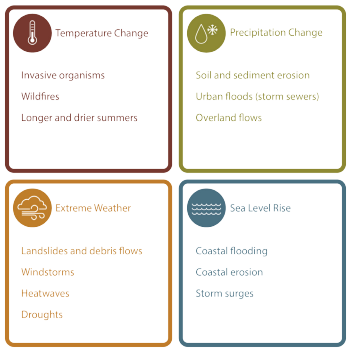Understanding and Assessing Impacts
Infrastructure design has traditionally been done by engineers and planners looking to past climate conditions; however, given the expected climatic changes (temperature, precipitation, extreme weather, and sea level rise), this is no longer an appropriate indicator of future conditions. The District uses climate modelling in considering the range of projected climatic changes in the area, while understanding the inherent uncertainty associated with climate models. Climate change is expected to impact the District’s ability to maintain current day-to-day operations and services; the District’s infrastructure and systems (e.g., changing weather conditions and sea level rise are damaging grey infrastructure, green infrastructure, and eco-assets); Parks and environment (e.g., The District possesses a variety of invaluable and irreplaceable eco-assets, from saltwater marshes to alpine meadows, many of which are expected to be significantly altered by climate change); and health and safety (e.g., an increase in extreme events can negatively impact community livability and increase risk to human health and safety). With an understanding of these types of changes and their associated uncertainties, interdepartmental working groups considered how the future climate will impact the District’s infrastructure, environment, staff, residents, and responders. The District recognizes adaptation as an opportunity to increase resiliency by reducing long-term costs through risk-based asset management, proactive environmental management and protection, and enhanced public safety systems.
